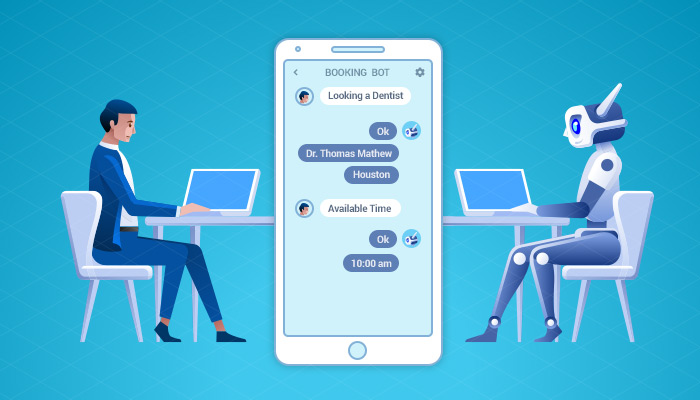
Practical uses for artificial intelligence have long been only theoretical, but these technologies and applications have been evolving so rapidly that we are now in a period where artificial intelligence is being implemented in almost every industry, on a global scale. Since AI promises to be one of the most efficient technologies for effective cost reductions, it’s use in the medical industry will likely be adopted faster than in other less-cost intensive industries. We are already seeing widespread adoption of Artificial intelligence in several key areas related to clinical care. One of these is the use of chat bots, or bots, in patient portals.
In relation to these portals, bots can have a large impact in many functions that serve to enhance the patient experience and streamline mundane processes for the providers. With their ability to ‘learn’ from their interactions and understand natural language patterns, there is no doubt that the capabilities of these bots will continue to increase.
For patients, their convenience can be enhanced in several ways.
- Insurance – Bots can provide customers an easy way to ask questions about their benefits as well as the status of their claims. They can assist with finding in-network providers and locations that can treat patients. Payments can also be made online in many cases.
- Pharmaceutical Management – Bots can assist with almost all aspects of medicine management, from reminding patients of when to take their medications or refill/renew their prescriptions, to assisting with education about side effects and drug interactions.
- Scheduling –Many tasks that were completed manually in the past, related to scheduling can now be done using Artificial Intelligence. Appointment requests can be submitted by patients using bots, and appointment reminders can be delivered to patients automatically.
- Intake – Bots can help to triage patients by compiling their demographic and clinical information and combining it with their current symptoms. Patient questionnaires can also be administered digitally by a bot, allowing for streamlined visit that saves both patient and provider time.
For providers, bots assist with their tasks in many ways as well.
- Billing – With the automation of insurance and payment information, billing is greatly simplified for not only the patient, but also the provider or facility. This is a task that has historically been completed manually in many instances, providing for the opportunity to achieve huge cost savings.
- Personalized Care – With a bot completing all of the heavy lifting in the data-collection, aggregation and prioritization, a medical provider can quickly learn most of the essential facts needed to provide an excellent standard of care in a small amount of time. This leads to a greater standard of care as well as increased patient satisfaction.
- Documentation – Bots can easily move patient responses and visit data into their electronic health record, which provides for a much more comprehensive capture of a patient’s history that has previously been feasible.
- Care Advice – For minor problems, bots can redirect patients to information that can assist them with self-care. They can also provide after-care advice once a patient is discharged or leaves a medical facility.
Smart deployment of artificial intelligence apps should help physicians trust the decision support tools. https://t.co/ouwjDwNZPP
— blueEHR | Health IT (@zhhealthcare) January 31, 2018
In case you missed it: artificial intelligence and the future of health tech. https://t.co/opeqqRY2Yj
— blueBriX | Health IT (@zhhealthcare) December 12, 2017
The downside of patient portal bots
As with any technology, the use of bots in patient portals presents a great opportunity to improve upon existing technology, but it also comes with great challenges as well. Chatbots rely on digital technology and algorithms, which opens them up to cybercrime vulnerability. This can ultimately put sensitive patient data at risk. Protecting against this will require diligent supervision of digital security measures to regulate the bots, as well as updating all bots in a timely manner. It may also be necessary to be vigilant in monitoring their licenses.
[Read More: https://bluebrix.health/blogs/artificial-intelligence-ehr-health-technology/]
The other key thing to remember is that while bots may improve upon efficiencies in many areas, they cannot function without direction, and it may be necessary to incorporate staff that know how to interact with the bots. They are only capable of a specific set of tasks, meaning that human intervention will be necessary when patient needs deviate from the capabilities of the bots. Bots also lack the capacity to judge the severity of conditions in certain instances. Under normal circumstances, a bot may prioritize a pneumonia case over asthma, however, during an acute attack that is severe, the asthma patient may need to see a physician more urgently than the pneumonia patient. The capacity of a bot to judge this situation accurately is limited, unless there is human guidance.
It is no secret that health care is incredibly expensive, and with the efficiencies that bots can provide, this technology seems to be poised to revolutionize care in a way that streamlines the process for providers in a way that allows them to focus on providing a better standard of care and improving medical outcomes. The patient experience is also enhanced by capturing a more comprehensive image of their health and history. However, implementing bots into patient portals should be done only when there is also a comprehensive understanding of the limitations and risks with the use of the technology. A plan to address these challenges should be developed prior to implementing the bots. When done thoughtfully and carefully, risk can be minimized while care is enhanced.